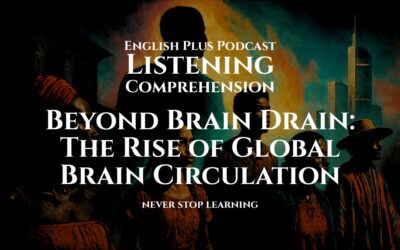A Closer Look: Listening Practice on Nanomedicine
Welcome to the final post in our listening comprehension series! Today, we’re delving into the microscopic world of nanomedicine. This topic will challenge you to follow detailed descriptions of processes and applications, a key skill for academic success and for exams like the SAT, TOEFL, and IELTS.
To maximize your performance, keep these strategies in mind:
- Visualize the Process: The speaker will describe things happening on a scale you can’t see. Try to create a mental picture. When you hear about nanoparticles delivering drugs to a cancer cell, imagine a tiny package finding its target.
- Listen for Purpose and Application: For each technology mentioned (nanosensors, nanofibers, etc.), ask yourself: What is it used for? What problem does it solve? The questions will likely focus on these applications.
- Note Cause and Effect: Listen for language that signals relationships. “This allows us to…” indicates an effect or benefit. “The main challenge is…” points to a problem.
- Grasp the Big Picture: While the details are important, don’t lose sight of the overall theme. The lecture will likely conclude with a summary of the potential and the challenges. Make sure you understand the speaker’s final message.
You are about to hear a guest lecture from a biomedical researcher.
Listen
Transcript
Listening Transcript: Please do not read the transcript before you listen and take the listening comprehension quiz.
Good afternoon. It’s a pleasure to be here. I want you to imagine a world where we can treat cancer without the debilitating side effects of chemotherapy, where we can detect diseases like Alzheimer’s years before the first symptoms appear, and where we can repair damaged human tissue using scaffolds built on a microscopic scale. This might sound like science fiction, but it is the world that my field, nanotechnology, is actively trying to build. Today, I want to give you an overview of the revolutionary role that nanotechnology is beginning to play in medicine.
First, what exactly is nanotechnology? It refers to the science, engineering, and technology conducted at the nanoscale, which is about 1 to 100 nanometers. To give you some perspective, a single human hair is about 80,000 to 100,000 nanometers wide. A nanometer is a billionth of a meter. At this incredibly small scale, the properties of materials can change dramatically. We can manipulate individual atoms and molecules to create new structures with unique abilities. It’s this ability to build from the ground up that gives nanomedicine its extraordinary potential.
Perhaps the most well-developed application of nanotechnology in medicine is in targeted drug delivery. Conventional chemotherapy, for instance, is a blunt instrument. It floods the entire body with powerful toxins that kill cancer cells, but also harm healthy cells, leading to severe side effects like nausea and hair loss. Nanotechnology offers a more elegant solution. We can engineer nanoparticles to act as tiny delivery vehicles. We can load these nanoparticles with a potent dose of a drug and then coat their surface with special molecules that act like a homing signal. These molecules are designed to bind only to specific receptors found on the surface of cancer cells.
The result is that these nanoparticles circulate harmlessly through the bloodstream, ignoring healthy tissue, until they find and attach to a tumor. Once attached, they can release their drug payload directly into the cancer cell, killing it with maximum efficiency and minimal collateral damage to the rest of the body. This approach not only reduces side effects but also allows for the use of more powerful drugs that would be too toxic for conventional delivery.
The second major area is diagnostics. Early detection is often the key to successfully treating any disease. Nanotechnology is enabling the creation of incredibly sensitive diagnostic tools. For example, researchers are developing nanosensors that can circulate in the bloodstream and detect the earliest molecular signs of a disease, the so-called biomarkers. Imagine a sensor that could detect a single cancerous cell or the specific proteins that signal the onset of a neurodegenerative disease long before it causes any noticeable symptoms. These sensors could then send a signal to a wearable device, like a smartwatch, alerting you and your doctor to a potential issue at the earliest, most treatable stage. This would represent a fundamental shift from reactive to proactive healthcare.
The third area I want to touch on is regenerative medicine. This is the field focused on repairing or replacing damaged tissues and organs. Here, nanotechnology is used to create nanoscale scaffolds. For example, we can spin biocompatible polymers into incredibly fine nanofibers that mimic the natural extracellular matrix of the body—the structure that surrounds our cells and provides them with support. We can then seed these nanofiber scaffolds with a patient’s own stem cells. The scaffold provides the perfect environment, guiding the cells to grow and differentiate into new tissue, whether it’s new skin for a burn victim, new cartilage for a damaged joint, or even new cardiac tissue after a heart attack. The scaffold itself is often designed to be biodegradable, so it gradually dissolves, leaving only the newly grown, healthy tissue behind.
Of course, with such a powerful technology, we must also proceed with caution. The very properties that make nanoparticles so useful—their tiny size and high reactivity—also raise questions about their long-term safety. We have to rigorously study the field of nanotoxicity. What happens to these nanoparticles in the body over time? Do they accumulate in certain organs? Could they have unforeseen effects on cellular function? Ensuring the biocompatibility and long-term safety of these materials is a critical area of research that must keep pace with the development of new applications.
In conclusion, nanotechnology is not just about making things smaller. It’s about harnessing the unique properties of matter at the nanoscale to design revolutionary tools for medicine. From precisely targeted drug delivery and ultra-early diagnostics to tissue regeneration, nanomedicine is opening up new frontiers in healthcare. While there are significant challenges and ethical questions to address, particularly concerning long-term safety, the potential to improve human health is immense. We are truly at the dawn of a new era in medicine.
Listening Comprehension Quiz
Key Vocabulary and Phrases
- Nanotechnology:
- What it means: The branch of technology that deals with dimensions and tolerances of less than 100 nanometers, especially the manipulation of individual atoms and molecules.
- How it was used: The entire lecture focuses on this field, specifically its application in medicine (nanomedicine).
- Debilitating:
- What it means: (of a disease or condition) making someone very weak and infirm.
- How it was used: The speaker described the side effects of conventional chemotherapy as “debilitating,” highlighting the need for a better approach.
- Blunt Instrument:
- What it means: A method or action that is not precise or subtle and may have unintended, damaging effects.
- How it was used: Conventional chemotherapy was called a “blunt instrument” because it attacks the whole body, not just the cancer cells.
- Collateral Damage:
- What it means: Unintentional damage or harm done to the surroundings during an attack on a specific target. It’s a military term used metaphorically here.
- How it was used: The speaker explained that targeted drug delivery kills cancer cells with “minimal collateral damage” to healthy parts of the body.
- Diagnostics:
- What it means: The practice or techniques of identifying diseases from their signs and symptoms.
- How it was used: The lecture presented diagnostics as a second major area for nanomedicine, with nanosensors able to detect diseases earlier than ever before.
- Biomarkers:
- What it means: A measurable indicator of some biological state or condition. For example, a specific protein in the blood can be a biomarker for a disease.
- How it was used: Nanosensors are being designed to detect “biomarkers,” the earliest molecular signs of a disease.
- Regenerative Medicine:
- What it means: A branch of medicine concerned with developing therapies that regenerate or replace injured, diseased, or defective cells, tissues, or organs.
- How it was used: This was the third application area discussed, focusing on using nanofiber scaffolds to regrow tissue.
- Biocompatible:
- What it means: Not harmful to or rejected by living tissue.
- How it was used: The lecturer specified that the nanofibers used in scaffolds are made of “biocompatible” polymers, so the body does not have a negative reaction to them.
- Biodegradable:
- What it means: Capable of being decomposed by bacteria or other living organisms and thereby avoiding pollution.
- How it was used: The nanofiber scaffolds were described as being “biodegradable,” meaning they dissolve away naturally after the new tissue has grown.
- Nanotoxicity:
- What it means: The study of the toxicity of nanomaterials. It addresses the potential for nanoparticles to cause harm to living organisms and the environment.
- How it was used: The speaker introduced this as a critical area of research needed to ensure the long-term safety of nanomedicine.










0 Comments